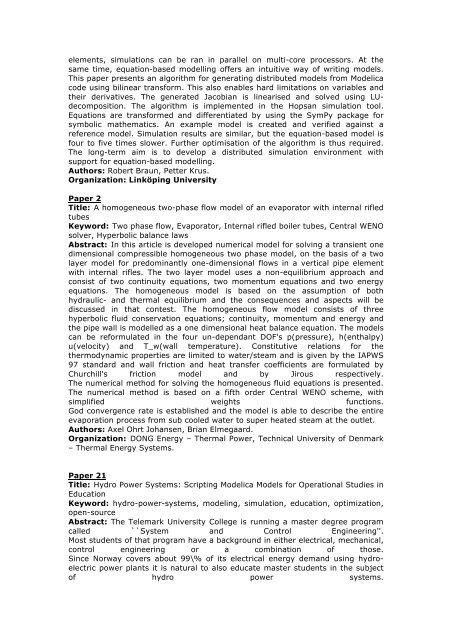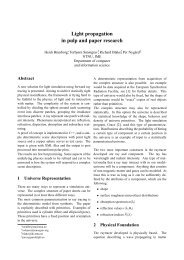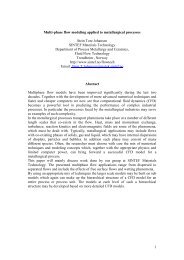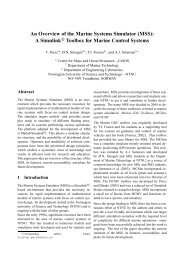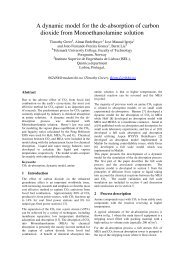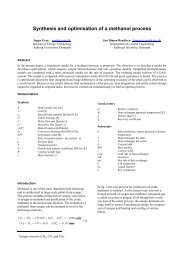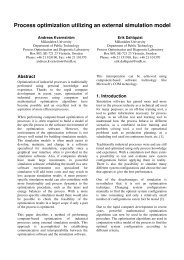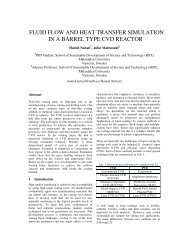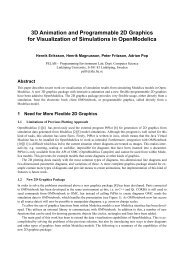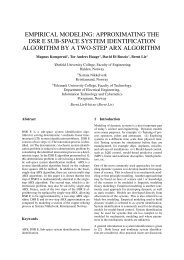detailed programme - SIMS - Scandinavian Simulation Society
detailed programme - SIMS - Scandinavian Simulation Society
detailed programme - SIMS - Scandinavian Simulation Society
Create successful ePaper yourself
Turn your PDF publications into a flip-book with our unique Google optimized e-Paper software.
elements, simulations can be ran in parallel on multi-core processors. At the<br />
same time, equation-based modelling offers an intuitive way of writing models.<br />
This paper presents an algorithm for generating distributed models from Modelica<br />
code using bilinear transform. This also enables hard limitations on variables and<br />
their derivatives. The generated Jacobian is linearised and solved using LUdecomposition.<br />
The algorithm is implemented in the Hopsan simulation tool.<br />
Equations are transformed and differentiated by using the SymPy package for<br />
symbolic mathematics. An example model is created and verified against a<br />
reference model. <strong>Simulation</strong> results are similar, but the equation-based model is<br />
four to five times slower. Further optimisation of the algorithm is thus required.<br />
The long-term aim is to develop a distributed simulation environment with<br />
support for equation-based modelling.<br />
Authors: Robert Braun, Petter Krus.<br />
Organization: Linköping University<br />
Paper 2<br />
Title: A homogeneous two-phase flow model of an evaporator with internal rifled<br />
tubes<br />
Keyword: Two phase flow, Evaporator, Internal rifled boiler tubes, Central WENO<br />
solver, Hyperbolic balance laws<br />
Abstract: In this article is developed numerical model for solving a transient one<br />
dimensional compressible homogeneous two phase model, on the basis of a two<br />
layer model for predominantly one-dimensional flows in a vertical pipe element<br />
with internal rifles. The two layer model uses a non-equilibrium approach and<br />
consist of two continuity equations, two momentum equations and two energy<br />
equations. The homogeneous model is based on the assumption of both<br />
hydraulic- and thermal equilibrium and the consequences and aspects will be<br />
discussed in that contest. The homogeneous flow model consists of three<br />
hyperbolic fluid conservation equations; continuity, momentum and energy and<br />
the pipe wall is modelled as a one dimensional heat balance equation. The models<br />
can be reformulated in the four un-dependant DOF's p(pressure), h(enthalpy)<br />
u(velocity) and T_w(wall temperature). Constitutive relations for the<br />
thermodynamic properties are limited to water/steam and is given by the IAPWS<br />
97 standard and wall friction and heat transfer coefficients are formulated by<br />
Churchill's friction model and by Jirous respectively.<br />
The numerical method for solving the homogeneous fluid equations is presented.<br />
The numerical method is based on a fifth order Central WENO scheme, with<br />
simplified weights functions.<br />
God convergence rate is established and the model is able to describe the entire<br />
evaporation process from sub cooled water to super heated steam at the outlet.<br />
Authors: Axel Ohrt Johansen, Brian Elmegaard.<br />
Organization: DONG Energy – Thermal Power, Technical University of Denmark<br />
– Thermal Energy Systems.<br />
Paper 21<br />
Title: Hydro Power Systems: Scripting Modelica Models for Operational Studies in<br />
Education<br />
Keyword: hydro-power-systems, modeling, simulation, education, optimization,<br />
open-source<br />
Abstract: The Telemark University College is running a master degree program<br />
called ``System and Control Engineering''.<br />
Most students of that program have a background in either electrical, mechanical,<br />
control engineering or a combination of those.<br />
Since Norway covers about 99\% of its electrical energy demand using hydroelectric<br />
power plants it is natural to also educate master students in the subject<br />
of hydro power systems.


